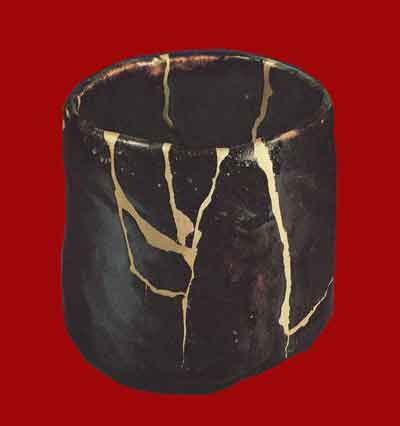Translated Vase
Ceramic trash, aluminum bar, epoxy, 24K gold leaf
2002 / 2006 - 2011
I took ceramic trash from a ceramic master who reproduces old Korean ceramics such as Joseon Baekja or Celadon.
After baking in a kiln by using the old method, ceramic masters break almost 70 percent of the porcelains that don¡¯t reach up to their standards of masterpieces.
I put the broken bits and pieces of ceramic trash together one by one as if I'm putting together a jigsaw puzzle. And I cover the seams with 24 karat gold leaf.
The result was uncanny and bumpy objects. Each broken piece operates as a self forming into an infinite proliferation toward as unexpected fabrication--fictitious loquacity and stuttering discards from standard conventional masterpieces.

Perfection Through Imperfection
There's a Japanese story of a man who had bought a beautiful new vase, immaculate, created by a master. He wanted to show this piece to his friend after the tea ceremony. But since the vase was so new and immaculate, he was ashamed of presenting it to his friend like this. So he took a brush and dipped it into gold varnish which is used to cover the glue in cracks and fissures in ceramics. He drew a line that looked like a crack in the new vase. Now it was looking old and mended, not perfect any more.
This is how he presented the vase to his friend, who immediately understood the matter. He admired this aged vase and regarded his friend with the highest esteem.

The Beauty of Simple Things
This tea bowl by the japanese artist HON' AMI KOETSU (1558-1637) is called "Seppo", which means "Snowcapped Mountain". Koetsu is one of the most outstanding artists of the early 17th century. He was famous for his tea aesthetics, landscape gardening, poetry, lacquering and pottery.
This very famous tea bowl was broken and was reparied with gold varnish. The cracks in the bowl have been filled with a kind of resin, then lacquered, and covered with gold powder before the lacquer dried. (One can also polish the gold afterwards). This technique is called "kintsugi" or "kin zukuroi", which means "repairing with gold".
The repaired bits of the bowl were given a philosophical interpretation of melting snow and streaming water. (The current owner of the bowl is the Hatakeyama Memorial Museum of Fine Art Japan).
Li Xiaofeng
Livia Marin
חזרה לעמוד קודם